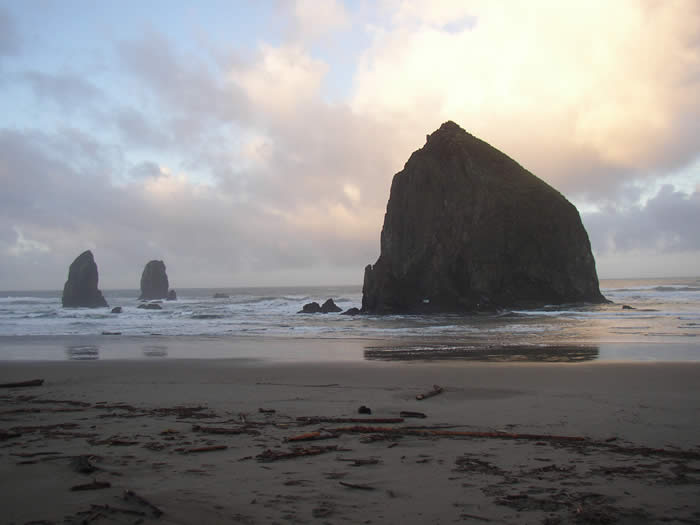NOTE: The listed coordinates will take you to the information
koiske that provides the needed answers for the EC. You can go to
the provided waypoint to get photos of the EarthCache. You can take
the picture anywhere you like of the Haystack Rock formation.

From this spot you can see a number of the towering rocks that
were created through the ocean's erosion process. But look quick!
The largest in view rising 235 feet above the ocean, Haystack Rock,
will not be there forever. It will be reduced to rubble by storm
waves sometime in the next few millennia. Even the basalt can not
stand up to the incredible power of the ocean forever.
Haystack Rock is the third largest coastal monolith in the
world. Haystack Rock is protected as part of the Oregon Islands
National Wildlife Refuge as well as a designated National
Wilderness Area. This basalt monolith is located on the scenic
Cannon Beach on the northern Oregon coast. The area below the rock
is referred to as a Marine Garden. The boundaries of this area are
between the extreme high tide line and extreme low tide line within
a 300 yard radius from the base of Haystack Rock. The tidepools in
the Marine Garden are dynamic areas rich with marine life such as
seastars, anemones, crabs, algae, and many others. Collecting is
strictly prohibited and it is crucial to be aware and use extreme
caution while walking in these areas. The marine life in and around
the Marine Garden is very vulnerable to human disturbance, and
research shows that in a small area everything can be killed with
just 200 steps an hour. So please be careful and try to walk only
on bare rock. Barnacles will cut like razor blades!
In addition to the diverse ecosystem of the rocky intertidal,
Haystack Rock is a vital habitat for an abundance of seabirds. Here
there over 2,000 seabirds that nest on Haystack Rock each year.
While viewing the rock from shore you might see the Tufted puffin,
Pigeon guillemot, Black oystercatcher, Pelagic cormorant and
others. These birds are extremely sensitive to human disturbance.
Getting too close to them can result in nest abandonment, dead
chicks, and failure to reproduce. Climbing is not allowed anywhere
on Haystack Rock, not only for the safety of the birds but for your
safety as well. As one of the Oregon Coast's most popular
destinations, Haystack Rock provides amazing opportunities to see
all kinds of marine wildlife in their natural habitat. So please be
mindful when enjoying this spectacular Oregon treasure.
For hikers, there are many trails to the water through the thick
conifer forests of Ecola State Park. Ecola Point, near Ecola State
Park, has a viewpoint and picnic area, where you can see the whole
panorama of Cannon Beach, Haystack Rock and the Coast Range. This
spectacular view is one of the most photographed on the Oregon
coast. A two mile trail connects Ecola point to horseshoe shaped
Indian Beach, and a six mile trail leads on to Tillamook
Head.
Haystack Rock is called a Basalt Monolith. A monolith is a
geological feature such as a mountain, consisting of a single
massive stone or rock, or a single piece of rock placed as, or
within, a monument. Erosion usually exposes the geological
formations, which are most often made of very hard and solid
metamorphic or igneous rock.
Composed of basalt, Haystack Rock was formed by lava flows
emanating from the Grand Ronde Mountains 10 to 17 million years
ago. The lava flows created many of the Oregon coast's natural
features, including Tillamook Head, Arch Cape, and Saddle Mountain.
Haystack Rock was once joined to the coastline but years of erosion
have since separated the monolith from the coast. Three smaller,
adjacent rock formations to the south of Haystack Rock are
collectively called "The Needles".

On Earth, most basalt magmas have formed by decompression melting
of the mantle. Basalt has also formed on Earth's Moon, Mars, Venus,
and even on the asteroid Vesta. Source rocks for the partial melts
probably include both peridotite and pyroxenite. The crustal
portions of oceanic tectonic plates are composed predominantly of
basalt, produced from upwelling mantle below ocean ridges.
The term basalt is at times applied to shallow intrusive rocks
with a composition typical of basalt, but rocks of this composition
with a phaneritic groundmass are generally referred to as dolerite
or gabbro.
To get credit for this EC, post a photo of you (NO PHOTOS OF JUST A
HAND ALLOWED) with Haystack Rock in the back ground and please
answer the following questions.
1. How old is Haystack rock?
2. Estimate the height of Haystack Rock.
3. What is the elevation at the posted coordinates?

Logs with no photo of the actual cacher logging the find,
posting the answers or failure to answer questions, and negative
comments will result in a log deletion. Exceptions will be
considered if you contact me first (I realize sometimes we forget
our cameras or the batteries die). Logs with no photos will be
deleted without notice.
I have used sources available to me by using google search to get
information for this earth cache. I am by no means a geologist. I
use books, internet, and asking questions about geology just like
99.9 percent of the geocachers who create these great Earth Caches.
I enjoy Earth Caches and want people to get out and see what I see
everytime I go and explore this great place we live in.